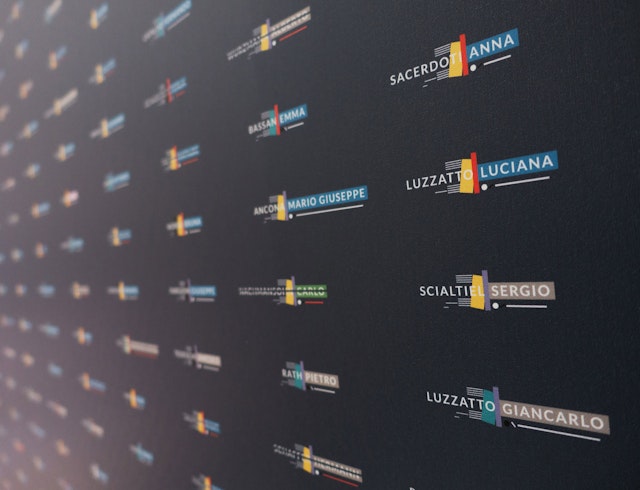
Each data portrait has an individual’s name at the center with visual identifiers surrounding it and creating a micro-illustration as unique as a fingerprint.




While the vast scale conveyed the magnitude of the historical event, the thousands of individual data portraits delivered the emotional impact of the human story.


Giorgia Lupi and her team at Accurat designed a stunning visualization of data collected during the August 22, 1938 census in Milan, a pivotal event in Italian history that forever altered more than ten thousand Jewish lives. The evocative installation appeared in ...ma poi, che cosè un nome? (...but then, what’s in a name?), an exhibition marking the 80th anniversary of the fateful census in the main hall of Milan’s Triennale Design Museum.
The 1938 census had been the Italian Fascists’ first direct, discriminatory act against Jews on a national scale. The process led to the anti-Semitic laws that ultimately deprived thousands of Italian Jews of their rights, property, freedom, and in many cases, their lives. Historians had considered the 1938 census documents lost until they were rediscovered in 2007 and moved to the Cittadella degli Archivi. With the support of the CDEC Foundation, the University of Milan conducted extensive research on the archived documents. The researchers built an extremely rich dataset comprised of personal information about the 10,591 Jews who had been subjected to “race verification” through the census.
CDEC Foundation commissioned Lupi and her team to translate the dataset into an original visual narrative for the 80th anniversary exhibition. Lupi designed a system of colors and shapes to represent the data points of gender, occupation, citizenship, and other aspects of personal history. The team then applied the design scheme to all of the census respondents digitally, generating thousands of “data portraits.” Each portrait has an individual’s name at the center with visual identifiers surrounding it and creating a micro-illustration as unique as a fingerprint.
From a distance, the names spread across the mural became almost indistinguishable, but color patterns revealed shared biographical information among groups of people. Arranged in columns and sorted left to right by age, data portraits of students dominated the left side of the wall, retirees dominated the right side, and a complex mix of professionals populated the middle. The central installation covered more than 100 square meters of wall space. While its vast scale conveyed the magnitude of the historical event, the thousands of individual data portraits delivered the emotional impact of the human story.
A secondary wall measuring 20 meters by 3.5 meters allowed for a different, more analytical approach to the exhibition. It presented an overview of the project, explained the archive structure, and provided a legend and instructions on how to read the visualization on the main wall.
...ma poi, che cosè un nome? was presented by CDEC Foundation in cooperation with the University of Milan, Cittadella degli Archivi, and the Holocaust Memorial Foundation in Milan. It shared the results of the census and the subsequent discrimination faced by the Jewish Milanese community for the first time. Lupi’s unusual design created an appropriately compelling narrative space that encouraged contemplation of history and social issues that remain relevant today.
